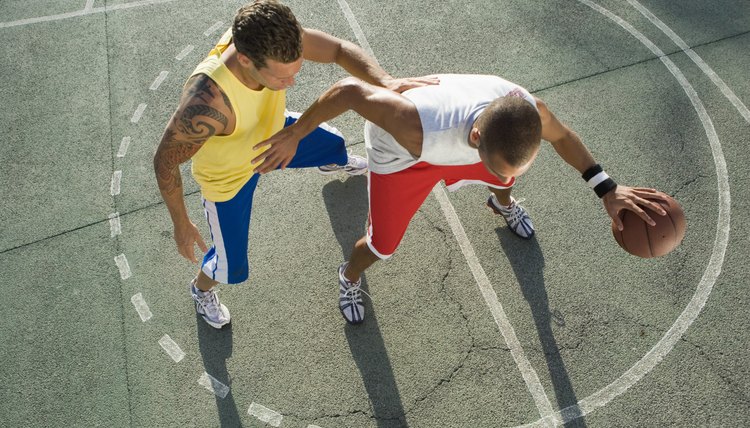What does fact checked mean?
At SportsRec, we strive to deliver objective content that is accurate and up-to-date. Our team periodically reviews articles in order to ensure content quality. The sources cited below consist of evidence from peer-reviewed journals, prominent medical organizations, academic associations, and government data.
- PubMed: Physiologic and Perceptual Responses During Treadmill Running with Ankle Weights
- PubMed: Physiologic and Perceptual Responses During Treadmill Running with Ankle Weights
The information contained on this site is for informational purposes only, and should not be used as a substitute for the advice of a professional health care provider. Please check with the appropriate physician regarding health questions and concerns. Although we strive to deliver accurate and up-to-date information, no guarantee to that effect is made.
Do Ankle Weights Help With Basketball?

The principle is a simple one. By wearing ankle weights, you will force your feet, ankles, lower legs and knees to work harder and build more muscle. By getting stronger in those areas, you will jump higher and run faster. Those two factors will make you a more competitive basketball player. However, if you have any injury problems or don't warm up properly, you can put yourself at risk by wearing ankle weights.
Warm Up First
Don't go into a practice session and put your ankle weights on before you have warmed up properly. Do all your warm-up exercises before you put on ankle weights so you don't stress your feet or legs. Run the baseline drill, do jumping jacks and do a shuttle run. You may even want to scrimmage for a while. Once you are warmed up, you have a better chance of gaining leg strength and not getting injured while wearing ankle weights.
Start Light
The ankles are very vulnerable, and ankle weights must be light. Start off by wearing no more than 2 pounds on each leg. You can eventually work your way up to 5 pounds. Avoid programs that promise you huge gains if you wear 10-pound or 15-pound weights.
The Growth Factor
Wearing ankle weights during practice sessions can help your muscles grow bigger and do it faster. If you wear ankle weights when you are walking, running, jumping or practicing, your glutes, hamstrings, calf muscles and quadriceps will work harder. Dr. Anthony Luke, assistant director of orthopedics and primary sports medicine at the University of California-San Francisco, in an article in the LA Times, thinks ankle weights produce positive results for basketball players. "It's giving a better workout for those big muscles," Luke says.
The Down Side
The ankle is one of the most unusual joints in the body. Adding weight when you are exercising can cause the joint to work under very difficult conditions that could lead to injury. Kent Adams, director of the exercise physiology lab at Cal State Monterey Bay, believes ankle weights can cause stress on your joints and should be avoided. In addition to ankle pain, you can feel discomfort in your hips and knees; not to mention decreased speed during your game.
References
- Los Angeles Times: Ankle Weights: Pros and Cons
- PubMed: Physiologic and Perceptual Responses During Treadmill Running with Ankle Weights
- American Academy of Orthopaedic Surgeons. OrthoInfo. Achilles Tendinitis. Reviewed June 2010.
- American Academy of Orthopaedic Surgeons. OrthoInfo. Arthritis of the Foot and Ankle. Reviewed March 2015.
- American Academy of Orthopaedic Surgeons. OrthoInfo. Ankle Fractures (Broken Ankle). Reviewed March 2013.
- Arthritis Foundation. Arthritis and Diseases that Affect the Ankle.
- Robati S, Porter K, Shahid M, Crompton T, Sandiford N. Ankle osteomyelitis: an unusual presentation. JRSM Short Rep. 2013;4(6):35. doi:10.1177/2042533313476682.
- Merck Manual Consumer Version. Tarsal Tunnel Syndrome. Revised March 2018.
- U.S. National Library of Medicine. MedlinePlus. Common peroneal nerve dysfunction. Reviewed August 7, 2017.
- Mascard E, Gaspar N, Brugières L, Glorion C, Pannier S, Gomez-brouchet A. Malignant tumours of the foot and ankle. EFORT Open Rev. 2017;2(5):261-271. doi:10.1302/2058-5241.2.160078
- Tiemstra JD. Update on acute ankle sprains. Am Fam Physician. 2012;85(12):1170-6.
- American Academy of Orthopaedic Surgeons. OrthoInfo. Sprained Ankle. Reviewed February 2016.
- Arthritis Foundation. Lab Tests for Diagnosing Ankle Problems.
- Merck Manual. Professional Version. Cellulitis. Reviewed September 2019.
- American Academy of Orthopaedic Surgeons. OrthoInfo. Compartment Syndrome. Reviewed October 2009.
- American Academy of Orthopedic Surgeons. (n.d.). Arthritis of the Foot and Ankle.
- American Academy of Orthopedic Surgeons. (n.d.). Sprained Ankle.
- Koehler SM, Eiff P. (2018). Overview of Ankle Fractures in Adults. Asplund CA, ed. UpToDate. Waltham, MA: UpToDate Inc.
- Mascard E, Gaspar N, Brugieres L, Glorion C, Pannier S, Gomez-Brouchet A. Malignant tumours of the foot and ankle. EFORT Open Rev. 2017 May;2(5):261-71.
- Robati S, Porter K, Shabid M, Crompton T, Sandiford N. Ankle osteomyelitis: An unusual presentation. JRSM Short Rep. 2013 Jun;4(6):35.
Writer Bio
Steve Silverman is an award-winning writer, covering sports since 1980. Silverman authored The Minnesota Vikings: The Good, The Bad and The Ugly and Who's Better, Who's Best in Football -- The Top 60 Players of All-Time, among others, and placed in the Pro Football Writers of America awards three times. Silverman holds a Master of Science in journalism from the Medill School of Journalism.
